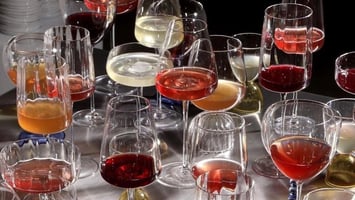The biggest misconception with wine is that white and red should be stored at different...
Sheep in Vineyards are the New Agriculture Trend Straight From the Past

Sheep aren’t just good for wool, surprisingly, they’re pretty helpful on vineyards too. Shepherds and their flocks of sheep are making a resurgence in wine culture. As a once traditional ancient practice, these gentle, helpful creatures are becoming the new face of farming for wineries looking for more cost-effective and environmentally conscious approaches to care for their grapes.
Why Sheep?
Sheep are one of the first domesticated animals, dating back between 11,000 and 9,000 BCE. Previously sheep were kept for their meat, milk, and skins, but by 6,000 BCE they made their way to Europe where their wool and eventually, their grazing habits, were of higher value.
No one seems to know exactly when sheep made their way onto vineyards, but the date falls somewhere in the Middle Ages. While not widespread, sheep were sometimes used to graze the pasture–eating up weeds and producing fertilizer great for growing grapes. Though, other specialized farming techniques such as tillage and pesticides were introduced and more popular, phasing out the use of sheep.
How Sheep Are Used Today
Today, many wineries are looking towards sheep as a crucial part of regenerative farming, where soil and ecosystem health are key in creating more sustainable products and a better future. Sheep offer a whole slew of benefits. Besides their ability to control weeds and fertilize soil, they promote land biodiversity by inviting beneficial insects and microbes that naturally control pests and their hooves help aerate the soil and promote water infiltration, reducing the risk of erosion. As part of regenerative farming, they help keep carbon emissions low and soil from depleting–which erodes 10 to 100 times faster with industrial agriculture practices.
 In New Zealand, where there are 4.6 sheep for every person, it only makes sense to have these furry creatures help out. There, wineries often utilize sheep for leafplucking as the sheep are gentler and able to remove more internal leaves than machines or people. By doing a better job, they help open up the remaining leaves to increase airflow and reduce disease risks. Some growers even say leaves re-grow slower from the sheep pluckings.
In New Zealand, where there are 4.6 sheep for every person, it only makes sense to have these furry creatures help out. There, wineries often utilize sheep for leafplucking as the sheep are gentler and able to remove more internal leaves than machines or people. By doing a better job, they help open up the remaining leaves to increase airflow and reduce disease risks. Some growers even say leaves re-grow slower from the sheep pluckings.
Sheep are also growing in popularity for California wineries looking to combat wild fire risks. By having sheep in and around the vineyard, they take the usually tedious task of removing underbrush, leaves, and vegetation that are easily flammable.
Robert Sinskey Vineyards in Napa County,Calif. has integrated 55 sheep into his land which uses the sheep for seasonal grazing during the off season from December to mid-March. This time period is particularly crucial for vineyards, as no vines have grape buds for sheep to eat. Similarly, Navarro Vineyards in Mendocino County, Calif. has a herd of 200 to 300 babydoll sheep helping manage their weeds.
A lucky addition to having sheep on the vineyard is their added tourist appeal, because who doesn’t want to see some sheep? La Crema Winery in Sonoma County, Calif. practices regenerative farming, and with that, they have sheep and chickens on their land. While the use of these animals is for environmental purposes, the additional marketing use didn’t pass them. Their sustainability tour, Best of Vines, allows patrons to travel around the estate, site seeing sheep eating weeds and offers patrons a moment to feed their chickens.
How to Sheep
Robert Sinskey Vineyards, Navarro Vineyards, and La Crema Winery have more than just the use of sheep in common–they all have their own herds.
The choice of owning or renting sheep is dependent on vineyard and land size. For some wineries with larger land, owning sheep is a feasible option when the sheep have areas to graze when weeding isn’t necessary. Though owning comes with its own slew of work. Not only do you have your vines to take care of, you also have the sheep.
Though La Crema has worked it out that a ‘shepherd’ service from Sonoma Dorpers herd the sheep. Moving them from barn to vineyard every morning and evening, taking the weight of sheep care off the wineries shoulders.
For smaller wineries who don’t have the land or resources to own sheep, renting is a popular and feasible option. Companies such as Wooly Weeders work with vineyards by renting out sheep to come graze between vines. Wineries can request the sheep to come only when necessary and once the vineyard is clean, they’ll be taken back to Wooly with the help of their guide dogs.
All this to say, sheep are the perfect pet for a winemaker.
Follow us on Instagram to explore even more wine!



